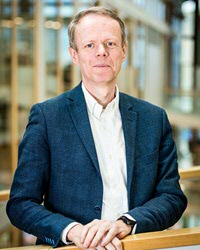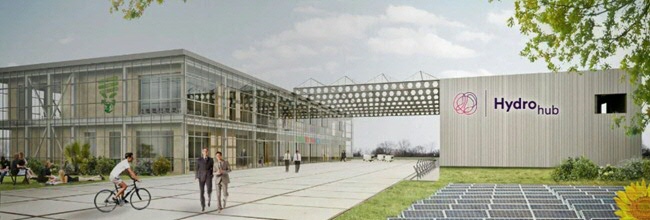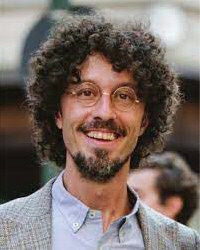Green hydrogen: indispensable and unifying
Partners researching the production of green hydrogen – Paolo Pescarmona is making key discoveries in a laboratory at the University of Groningen, while alumnus Jan-jaap Aué is leading a project at Hanze University of Applied Sciences to scale up this kind of knowledge into an industrially usable process. Northern knowledge institutions are collaborating on this project and others, within the University of the North. The plan is for the Northern Netherlands to evolve into a fully fledged ‘Hydrogen Valley’ (emulating the success of Silicon Valley).
It appears that many people are gradually starting to see green hydrogen as the ‘holy grail’ in our transition to a world without CO2 emissions. This is because hydrogen gas that is produced using green electricity is an excellent fuel. It can easily be stored in tanks and transported through gas pipelines.
‘Squeaky pop’ experiment
We all remember the hydrogen ‘squeaky pop’ experiment from secondary school chemistry lessons. Hang positive and negative electrodes in a bowl of water, pass electricity through the circuit, and – in a nerdy version of Moses parting the waters of the Red Sea – the water will split into oxygen and hydrogen (which is highly explosive). This process is called electrolysis. If this process is powered by green electricity (generated by wind turbines or solar panels), you get ‘fossil-free’ gas. However, it turns out that scaling up the hydrogen ‘squeaky pop’ experiment to an industrial level is no easy matter.

Scaling up production
For this reason, the University of Groningen and Hanze University of Applied Sciences have joined forces to research ways of producing green hydrogen affordably and on a large scale. ‘One of our joint projects is the Hydrohub, which is currently under construction at the Zernike Campus. The goal of our research at this “megawatt test centre” is to find the most efficient way of producing hydrogen from water. Incidentally, this is a collaborative venture with an industry consortium led by the Institute for Sustainable Process Technology (ISPT),’ says Jan-jaap Aué. The Physics alumnus is completely into green hydrogen. He is Professor of the Application of Hydrogen within the Energy Transition at Hanze University of Applied Sciences and director of EnTranCe – a consortium in which scientists, students, companies, government bodies, and societal institutions are collaborating to create a renewable energy supply.
A financial no-brainer
For starters, Prof. Aué is keen to point out that ‘the easiest way to make green hydrogen a financial no-brainer is simply to charge a fair price for fossil fuels.’ He explains, ‘A German banker once calculated what the CO2 charge should be for drivers who use fossil fuels such as petrol or diesel, if all of the effects involved are taken into account. In the Netherlands, the current charge is €50 per tonne of carbon dioxide. Realistically, however, that should be at least €200, if the associated costs of health effects and climate adaptation are included. At the moment, we pay these additional costs in the form of health insurance policies and water bills. If these extra costs were to be added to the product fairly, then the cost of renewable energy would simply not be an issue. Zero. By not daring to state the blindingly obvious, we are just sticking our heads in the sand.’

Better electrodes
At EnTranCe, Jan-jaap Aué’s leadership of the Hydrohub project reflects his passion for his work. Paolo Pescarmona, Professor at the University of Groningen, is also working on this project. His focus is on the system’s electrodes, or rather the material from which they are made. Those electrodes are key to the operation of the test centre. The Hydrohub’s two electrolysers can continuously produce one megawatt of green hydrogen energy. They each consist of a cylinder that is approximately six metres long and two metres in diameter, in which electrolysis takes place. Positive and negative electrodes alternate along the entire length of the cylinder. Pescarmona explains: ‘We are trying to improve the materials from which these electrodes are made. Firstly, this is a matter of efficiency or, in simple terms, the amount of hydrogen that the electrodes produce from a certain amount of electrical energy. Secondly, we are assessing electrode stability, in other words, how long the materials used will continue to perform properly (since they are subject to wear and tear). Thirdly, we want to know what happens if you stop the process of electrolysis and then restart it. This can happen with renewable energy, as the wind does not always blow and the sun does not always shine. Simply put, you need a system that can handle periodic stops and starts. This constant starting and stopping produces changes in some materials.’
Power lines as thick as your arm
For Pescarmona, the bonus of his collaborative venture with EnTranCe is the prospect of transforming the results of his fundamental research into real-world applications. ‘Without that collaborative venture, our research might still have led to the same result, but it would have been much more difficult to develop a practical application. Fundamental research is wonderful, of course, but we are also really keen to apply our results and see how they work on a larger scale. EnTranCe is giving us the opportunity to try that out, in Hydrohub.’ Prof. Aué notes that, ‘In projects of this kind, the University of Groningen tends to concentrate mainly on the fundamental issues. We, on the other hand, are much more focused on the best way to operate a megawatt electrolyser, and how that knowledge might be translated into operator training courses and design issues, for example. Some of our power lines are as thick as an arm, for example. Laying them around corners is no simple matter, you have to allow for a bend with a minimum radius. This, in turn, limits you to certain types of cable ducts. Also, the bigger the electrolyser, the bigger the problem of dissipating the heat that is generated in the core of the device. These are very practical matters, but finding effective solutions can be a very time consuming process. Nevertheless, the lessons learned will be very valuable to any future researchers who wish to build similar installations.’
A hurdle yet to be cleared
As a megawatt-scale test centre, Hydrohub is unique in Europe. It may indeed be a vital step from the lab to the industrial production of hydrogen, but the lack of green electricity is a hurdle that has yet to be cleared. ‘Even on good days for renewable energy generation, only a relatively small percentage of the electricity we use is green,’ says Jan-jaap Aué. ‘There is also a huge demand for that electricity, from consumers ranging from households to data centres, as well as the industrial sector. While there are peaks in the supply of green electricity, these are very short-lived, so you can’t run a factory on that. The cheapest way to operate is to run the electrolysers 24 hours a day, 365 days a year.’ Add to that the fact that about forty percent of the energy you put into the electrolysis of water is lost, and you may start to wonder whether green hydrogen really is the right way to go. At least, that is the logic of the environmental movement.
Indispensable
Nevertheless, Prof. Aué believes that green hydrogen has an indispensable part to play in the energy transition. ‘If you look at the amount of energy consumed by society and industry, you are forced to conclude that it will be very difficult to meet this demand from solar, wind, or geothermal sources alone. In addition, we tend to turn up the heating in the winter, a season with very little sunshine. Admittedly, there is a lot of wind at that time of year, but even that cannot redress the balance. If you want a system that is always in balance and that can meet demand, then you have to build up reserves. For short periods, batteries are a very effective way of storing electricity. However, batteries are expensive. Furthermore, they are not ideal when it comes to storing large amounts of electricity for long periods of time. For applications like that, your best option is to use green electricity to generate hydrogen. This may not be the most energetically efficient option, but it is an easy way of building up your energy reserves.’

Hydrogen Valley
Both Aué and Pescarmona believe that the Northern Netherlands’ transformation into Hydrogen Valley holds the prospect of a bright future. ‘The Netherlands just happens to be situated on top of an enormous gas field. Because of this, we have a great deal of knowledge and expertise, which are still being exported,’ says Prof. Aué. ‘That knowledge, together with the infrastructure that we already have in place, will come in very handy when we switch to hydrogen. It has been estimated that the oil and gas industry in the Northern Netherlands provides between 15,000 and 25,000 jobs. The office workers employed by Gasunie (an energy network operator) account for only a fraction of these jobs. There are also workers at maintenance companies and numerous suppliers who manufacture high-quality partial products. Hydrogen could be a useful alternative option for companies like these. It would enable them to preserve existing jobs and even create new ones. ‘If we can develop a local knowledge advantage in terms of cheaper and safer ways of producing green hydrogen, and if this is mirrored by the country’s industrial sector, then we will also have an export market.’
Network of gas pipelines
An added extra here is that, thanks to its position as a natural gas distributor in Europe, the Netherlands already possesses a high-quality network of gas pipelines. ‘I understand that only a relatively minor modification would be needed to make those gas pipelines suitable for hydrogen,’ says Prof. Pescarmona. ‘This means that we are ideally placed to produce hydrogen. There are plans for a large wind farm in the North Sea. The electricity it generates will come ashore in Groningen. So, strategically speaking, there are many reasons why the Groningen region is well suited to hydrogen production.’
Train chemical engineers
Pescarmona has yet another idea on how to further concentrate and share knowledge about green hydrogen: ‘I would like to see the University of Groningen establish a hydrogen centre or sustainability centre to serve everyone at the University who is involved with hydrogen. Some are exploring the associated infrastructure and logistics, or the fundamental development of materials, while others are looking into economic aspects and societal acceptance. It would be useful if someone researching the societal acceptance of hydrogen was aware of the potential scale of production, and of what that might mean for Groningen. That would also present opportunities for the University of Groningen itself. As the director of the Master’s degree programme in Chemical Engineering at the University of Groningen, I am also involved in training engineers from the region. Many companies tell me that they will soon need people with a knowledge of hydrogen production and electrochemistry. Could our University train people for future careers in these areas? I think that would be a fine mission for the University of Groningen.’
This article has been taken from our alumni magazine Broerstraat 5. Text: Bert Platzer
More news
-
19 December 2025
Mariano Méndez receives Argentine RAÍCES award
-
18 December 2025
Why innovate, and for whom?
-
17 December 2025
Ben Feringa wins Feynman Prize
